Credit: Biovision-Infonet and KEFRI
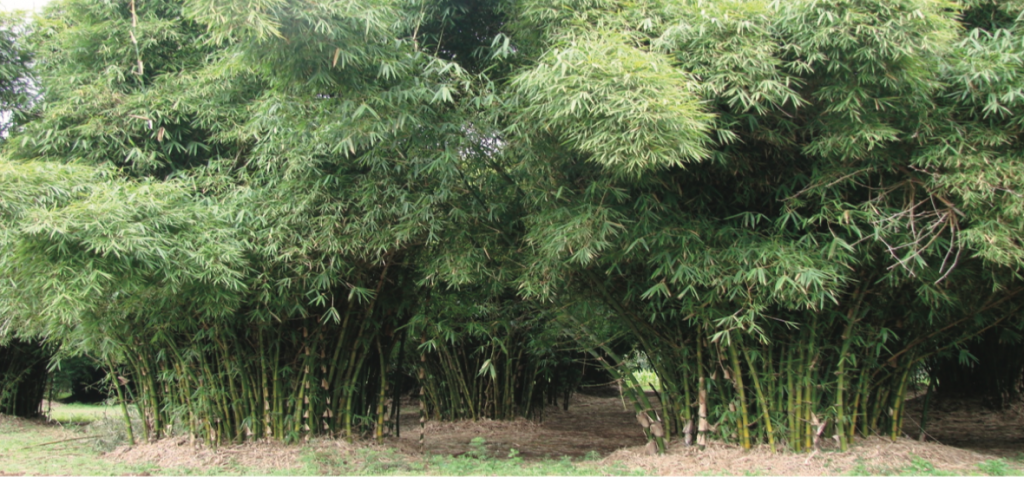
Local Names: Kamba (Muangi); Kikuyu (Murangi); Kipsigis (Terga); Luo (Mwodi); Maasai (Oldiani); Marakwet (Terga); Nandi (Tegat); Ogiek (Tegat); Sabaot (Tegendet): Swahili (Mwanzi); Taita (Mrangi)
1. Introduction
General Distribution:
Bamboo plays a vital role in protection of soil and water resources in forested catchment areas. In recent times, bamboo is increasingly becoming important as a source of materials for construction, cottage industry and biomass energy. Increased demand for bamboo resources cannot be met by bamboo from its natural populations. One of the options for increasing bamboo resource in Kenya is through domestication and introduction of the species on farms. Currently, the central highlands eco-region is facing a shortage of bamboo seedlings. This leaflet therefore aims to provide simple instructions on how to raise bamboo seedlings through different methods. Procedures of bamboo planting in the field are also highlighted.
The species forms the bamboo zone in moist highlands at 2,400 – 3,000 m. Found in the Timboroa Plateau and on Mts Kenya and Elgon and on Loita Hills and the Mau Range.
General Information about the Tree:
The Maasai make snuff containers from the stems. Plants die down after flowers and seeds are formed. All bamboos belong to the grass family
Biophysical Limits:
It has an upper limit of 3,360 m, Agro-ecological zones I-II.
2. Propagation and Tree Management
Bamboo seedlings can be raised from culm (stem), cuttings, seeds, wildings offsets and by tissue culture.
Propogation from culm (stem) cuttings
- 2-3 year old culms should be selected based on the colour of the stem. Young culms for most bamboos have a distinctive sheen (shine) which fades with age.
- Culms should be cut using a sharp panga just above the last node at the base approximately 30 cm from the ground.
- Prepare single , double or triple node cuttings. A whole culm can also be used as a cutting.
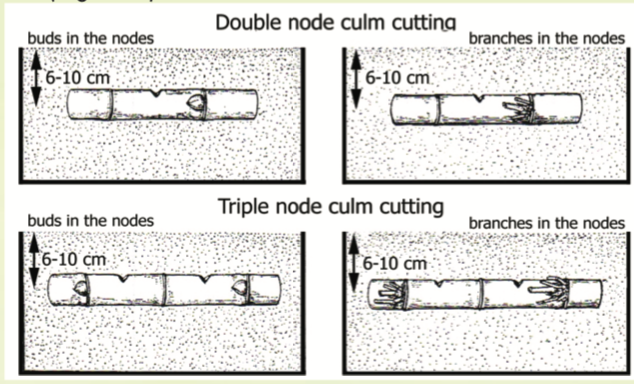
- Holes should be drilled at the internode as shown in Figure 1 using a sharp panga or hack saw.
- The part of the culm used should have live buds (eyes)
- Use sand mixed with a sub soil at a ratio 1:1 without manure/humus as a rooting medium.
- Lay the cuttings in a germination bed. Note cuttings should be planted the same day they are harvested.
- Use Anatone hormone to stimulate rooting. Prepare the hormone by mixing 3 grms Anatone with 50 its of water.
- Pour the hormone mixture into the holes.
- Cover the culms with the rooting media
- Watering of the cuttings should be done in the morning and the evenings
- After a period of 3 months the cuttings should have developed roots and shoots
- The cuttings should be carefully removed and transferred into the large sized potting tubes (Plate 1 )
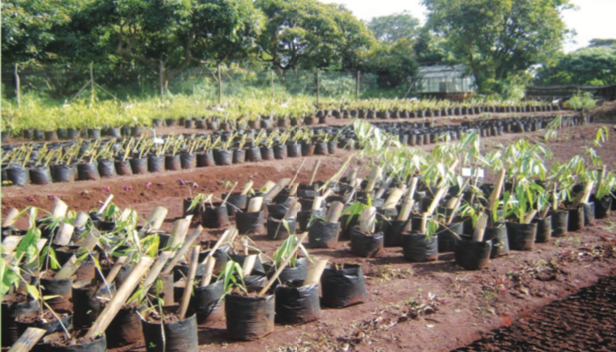
• In total it takes about six months for the seedling to be ready for field planting (Plate 2).
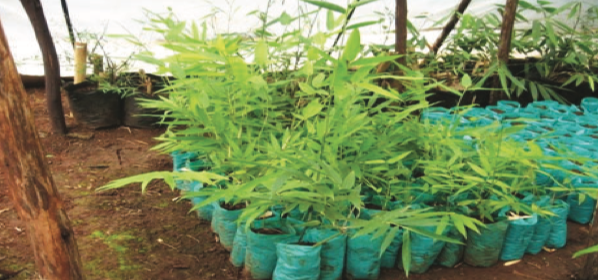
• Multiplying planting materials from rooted cutting through splitting to build planting stock in the nursery can be undertaken every three weeks (Figure 2).
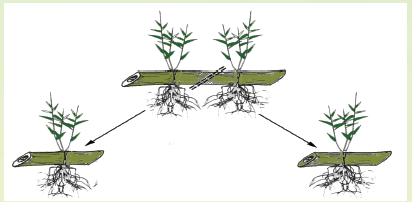
rooted cutting through splitting
Propagation by Seed
Flowering is rare in bamboo, but when it occurs, seeds produced can be carefully harvested, collected and processed for raising seedlings.
• Due to poor viability of bamboo seed, it is best to sow the seed immediately after collection.
• Sow seeds in the nursery bed or in polyethylene containers filled with a mixture of subsoil and sand in ratio of 1:1.
• Prevent direct sunlight by providing partial shading.
• Water the seeds twice a day.
• The seeds take about three weeks to germinate.
• Transplanting should be done once the germinants attain a height of 3 cm into small or medium size polyethylene tubes.
• Tend the seedlings for 8-12 months in the nursery to reach good-field planting size.
• Seedlings raised from seeds ready for field planting can be multiplied through splitting after every three weeks to raise enough seedlings for field planting (Figure 3).
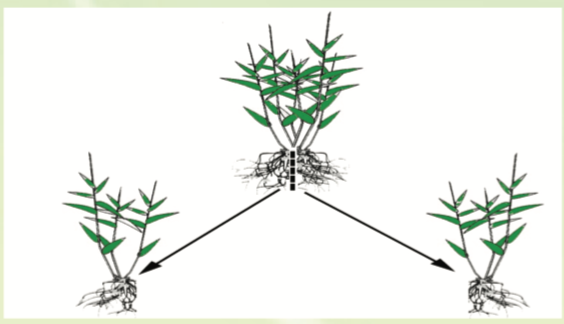
Propagation by Wildlings
Wildlings are seedlings germinated in the wild from seeds.
• Uproot the wildlings carefully to avoid damaging the roots.
• Once collected, the widlings should be kept in moist containers in the field and transferred to nursery.
• Pot the wildlings into small or medium size polyethylene tubes.
• Tend the wildlings for 8 months in the nursery to reach good-field planting size.
• Seedlings raised from wildlings ready for field planting can be multiplied through splitting after every three weeks to raise enough seedlings for field planting (Figure 3).
Propagation using Offsets
A bamboo culm with rhizome attached is called an offset (Figure 4).
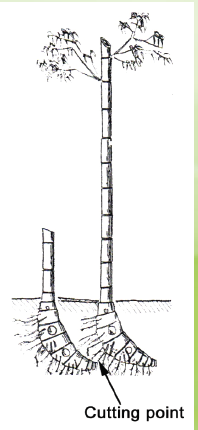
aerial culms
Generally offsets are bulky and therefore expensive in terms of labour and transport . Using offsets, a bamboo plant can be established much quicker and in two years after planting, mature culms can be harvested from the new clump.
• Get offsets at the onset of rains and just before the emergence of new shoots.
• Dig out 1-2 years old offsets without injuring the buds.
• Transport the offsets to the planting site without any delay (preferably the same day or the next day) and plant immediately.
• The planting holes for the offsets should be 60 cm x 60 cm and at a spacing of 5 m x 5 m for medium sized species and 7 m x 7 m for large sized bamboo species (Figure 5).

• The offsets should be protected from livestock and spot weeded.
Important Precautions!
• Offsets taken late in the rainy season after the new growth has started tend to fail once planted out. Collect offsets as early as possible.
• The younger the rhizome, the more the growth vigour in the buds.
• Larger diameter materials are better in establishment and survival.
• The larger the aerial culm, the better the chances of survival.
• Avoid damaging the junction of the culm and rhizome and the dormant buds.
• Do not delay planting offsets after digging them out. Early planted offsets root easily.
Propagation through Tissue Culture
Tissue culture can be used in advanced laboratory for rapid multiplication. The initial attempts that have been undertaken in our laboratories are promising and working jointly with our partners some positive outcomes will be realised.
Field Planting
Planting of container or potted seedlings should be done immediately at the start of the rainy season.
• For offsets removed from the forest, planting must be done the same day with a maximum delay of one night.
• The size of planting holes for seedlings raised from seeds and wildlings should be 30 cm x 30 cm while the holes for those from offsets and cuttings should be 60 cm x 60 cm (Figure 5)
Advantages and disadvantage of various types of bamboo propagation planting materials
Culm (stem) Cuttings
Advantages
• Rapid multiplication for some species
Type guaranteed
• Fast growth
Disadvantages
• Shorter life cycle than seed produced plants
• Long time needed to propagate large quantities of planting material
• Bulky plants hence high logistical costs
• Large propagation area needed
• Some species are difficult to propagate e.g.
Yushania alpina
Seeds
Advantages
• New generation (long life)
• Diversity of genotypes
• Low cost
• Small plants easy to transport to the field
• Opportunity for selection and macro proliferation
Disadvantages
• Limited viability
• Long time needed before plants are ready for planting
Offsets
Advantages
- Quality guaranteed
• Type guaranteed
• Success rate high with most species
• Opportunity for selection and macro proliferation
Disadvantages
- Bulky seedlings
• Labor intensive
• Long time needed to propagate large quantities of planting material
• High logistical costs
• Large propagation area needed
• Shorter life cycle than seed produced plants
• Limited clonal diversity
Tissue Culture
Advantages
- Mass production
• True-to-type plants
• Vigorous plants with multiple new shoots
• Very fast growth and high biomass production
• Small and vigorous planting materials
• Logistical advantages
Disadvantages
- Limited clonal diversity
• Shorter life cycle than seed produced plants
• High investment needed for propagation
• Require large orders to justify investment
Bamboo Products:
- Bamboo may be used as fodder.
- Making of furniture
- Source of poles for construction, utensils, food (shoots), fencing, and handicraft, (basketry)
Services:
- Ornamental
- Soil conservation
3. Pests and Diseases
There is no information about the disease and pests that affect A. alpine. It is not a serious problem though.
4. Information Source Links
- Maundu P. and Bo Tengnas. (2005) Useful trees and shrubs for Kenya, World AgroforestryCentre. www.worldagroforestrycentre.or
By Gordon Sigu, Bernard Kamondo, Paul Tuwei, Dorothy Ochieng and Josphine Wanjiku from KEFRI
- null
- KENYA FORESTRY RESEARCH INSTITUTE Central Highlands Eco-region Research Programme
P.O. Box 20412-00200 Nairobi, Kenya, Tel: +254 20 2116399
E-MAIL: cdmuguga@kefri.org, WEBSITE: www.kefri.org